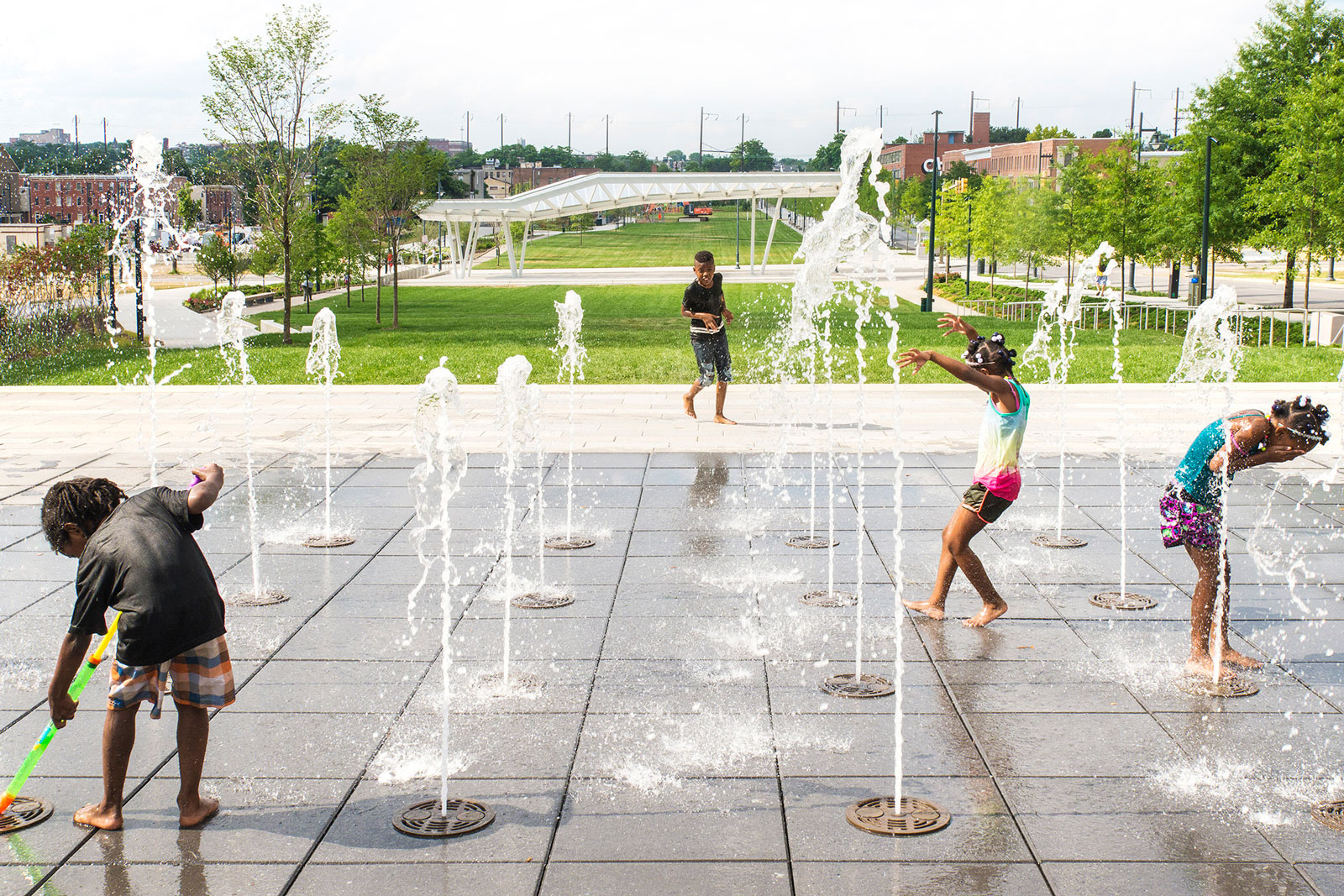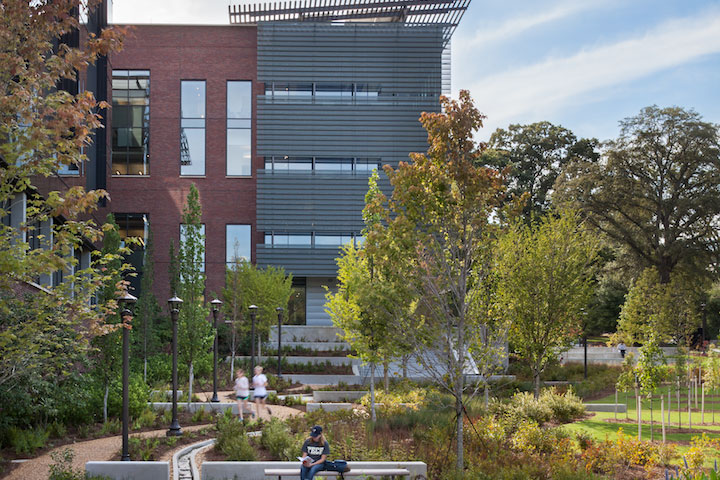
The 218,880-square-foot, LEED-NC certified Georgia Tech Engineered Biosystems Building includes expansive green space implemented by landscape architect Nelson Byrd Woltz. Photo courtesy of Cooper Carry
Earlier this year, like many families around the world, my family unexpectedly found ourselves working and schooling in our small home in Atlanta, Georgia. As we adjusted to our new routine, we had our expected share of disagreements, but we could all agree that by 6pm each evening we had to get outside. We started taking evening walks.
In May we discovered six Mulberry trees on our route, brimming with ripening fruit. We walked that same route every evening to pick fruit from the trees—just enough to snack on as we meandered along the path, leaving the bulk to remain for the birds, other neighborhood grazers, and our daily returns.
Plucking and eating fruit from trees on public and vacant land presented an opportunity to talk with my family about our food and where it comes from—specifically local food. As we battled a public health crisis that required us to remain within a certain local radius for the safety and well-being of ourselves and others, we recognized the significant gaps in the availability of locally grown food in our community.
According to a 2009 study by the US Department of Agriculture, 23.5 million Americans live in food deserts, geographic areas where access to affordable, healthy food options (including fresh fruits and veggies) is limited or nonexistent because grocery stores are too far away. Nearly half of these people are low-income.
Meanwhile, the Center for Urban Education about Sustainable Agriculture (CUESA), a nonprofit focused on expanding access to local food, estimates most food in the US travels an average of 1,500 miles from its harvest location before ending up on our plates. Ill effects of climate stress aside, much of the fresh food transported across long distances is already locally grown and could be consumed by people living in those areas. While the high levels of importing and exporting may keep costs low, what are they really costing our society in the long run?
See Also: Green Roof Benefits Far Exceed Sustainability
You could say our food system is ripe for improvement; there is plenty of credible research and conscientious sources from within the last 10 years to validate that. We also have a wealth of information on how we can best shift our dining and shopping habits to better support locally grown food. Buying groceries at the local farmers market, cultivating a home garden, or participating in a community-supporting agriculture (CSA) program are all great examples, but there is still much work to do to increase accessibility and ensure sustainability of these models.
Despite this abundant knowledge, a divide exists in the information being directed to design professionals about how we can make a substantive difference in food production through physical spaces. As planners and designers, we have a responsibility to address inequity in the built environment, which includes determining how we grow and distribute food and eliminating barriers to participate in the process. Here are three ways we can start.
1. Consider food production as a critical component of every design plan.
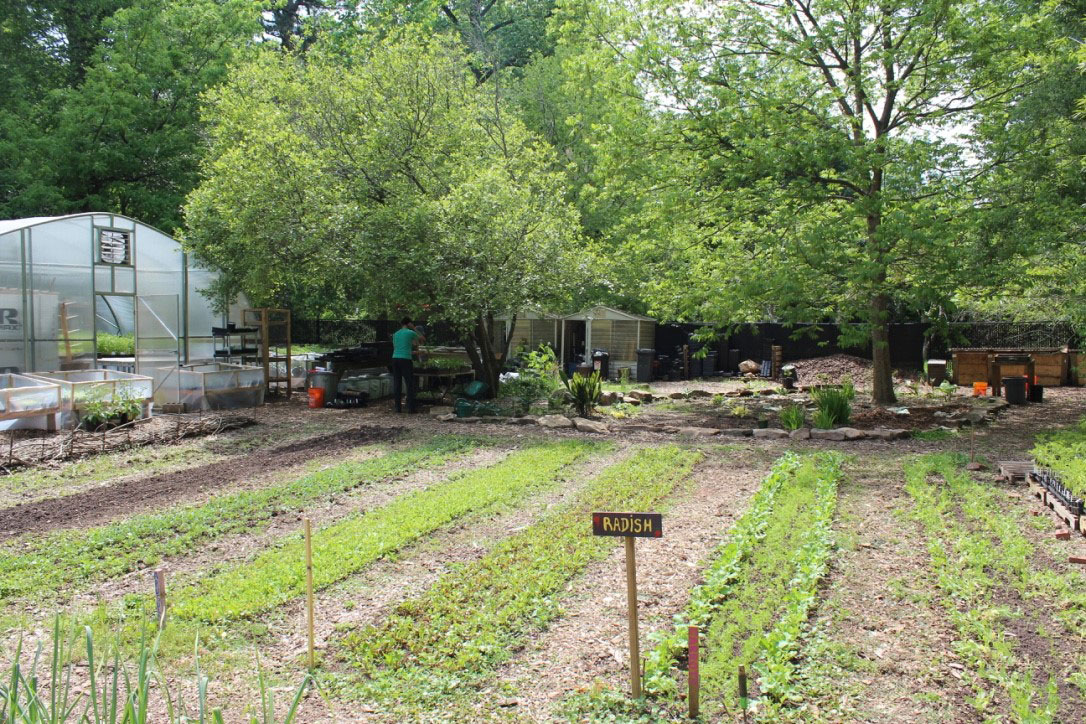
Courtesy of Wylde Center
Designers arrive at every project with their intellectual toolkit, packed with proven techniques to address issues in our world, from activating streetscapes with a vibrant mix of restaurants and retail to amplifying the pedestrian experience with appealing plantings and site furnishings.
As local food and production are increasingly considered as part of the toolkit, we can then begin introducing these concepts at the design level, a point at which these solutions have a greater chance of remaining in the project and serving their intended purpose.
The sky is the limit when it comes to implementing a food-focused design strategy, whether it looks like planting fruit trees along public sidewalks, housing beehives within an office park, or allocating a space for a rooftop community garden in a multifamily development. For example, in Alexandria, Virginia, design firm Cooper Carry is working with the Alexandria Housing Development Corporation to redevelop the site of a homeless shelter into a mixed-use building with an affordable housing component known as “The Bloom.” A roof terrace and 2,000-square-foot community garden are key aspects of the design, where residents can participate in gardening activities and programs about healthy eating as well as supplement their diet with fresh produce.
As director of the landscape architecture studio at Cooper Carry, my goal is to lead our firm into the next evolution of sustainable, biophilic design, addressing the evolving needs of communities and driving success for our diverse clients—regardless of whether we’re designing a multifamily community, hotel, office park, school, or other environment.
By increasing the prevalence of locally grown food in urban settings through inventive design solutions, we stand to confirm the normalcy of sustainably grown produce, shifting the status quo from imports and exports to backyard-to-table dining.
2. Connect interested growers to available land.
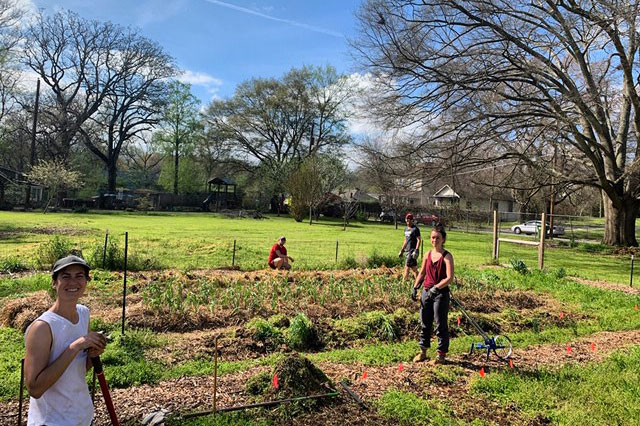
Courtesy of Wylde Center
Whether a vacant lot adjacent to a current project or an underutilized right-of-way that is part of a larger design effort, we as design professionals are regularly exposed to properties that have the potential to become farms and gardens.
Where others see overgrown weeds, derelict buildings, and decaying infrastructure, we see possibility and the signs that a site is primed for rehabilitation. In other words, we have a unique ability to view those favorable sites as food production opportunities and support action to begin the conversion process. However, while we could sow the seeds, we need others to help us toil, tend, and benefit from the fruits of our collective efforts.
Just as our metaphorical toolkit should now include techniques for building food production into the design, we should also be staunch supporters outside of work to further the movement to localize growing whole foods within the towns and cities in which these products will be consumed. Getting involved and supporting local organizations that support growers is a great start.
As an Atlanta resident, Georgia Organics comes to my mind as a prime example of the outgrowth of a grower’s association established in the 1970s. In the past 50 years the member-supported, nonprofit organization has evolved with the times and has garnered national recognition for the solid work they do connecting organic food from Georgia farms to Georgia families.
Prior to joining Cooper Carry, I served as the green space director of the Wylde Center in Decatur, Georgia. In this role I saw firsthand how educating and engaging the community in environmental science, sustainable urban living, and organic gardening can positively reinforce ideas around local consumption and encourage action behind this newfound insight. For example, The Food Well Alliance funded a three-year project at Wylde Center called “Healthy Living by Healthy Growing,” where we used available land in the center’s gardens to grow food for a local CSA. This allowed us to hire a farmer who would have otherwise had financial difficulty acquiring land needed to grow food to sell in a local CSA. We used the profits from the CSA to support our food education programs at the Decatur Housing Authority, which primarily focuses on building housing for low-income households. Patrons of the CSA were aware that their food subscriptions were not only providing fresh food but also programming to their underserved neighbors.
Simply put, supplying the information needed to incorporate the practice to our communities is a critical step in reimagining our food system for a post-pandemic world and beyond. Designers are versed in the language needed to advocate for a community interested in transforming their neighborhoods into food production hubs. For those who want to grow but are limited in their understanding of how design and planning plays into it, we can become their champions.
3. Improve local food policy.
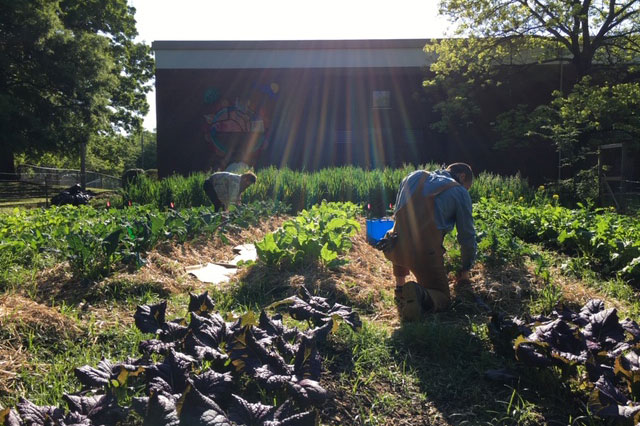
Courtesy of Wylde Center
As we come together to foster change, we also need the support of our government leaders, both on the local level and nationally.
Participation in local agriculture should not be cost prohibitive, and city governments are able to enact initiatives that mitigate the cost of entry to urban farming. Introducing programs that are directly supportive of urban agriculture is one method, such as creating community composts or decreasing expenses associated with water and electricity usage to support personal gardens.
Many large cities like Philadelphia and Minneapolis have led the way on implementing policies, however there is still incredible opportunity for smaller, more rural populations to benefit from changes to local legislation.
In our roles as cultivators of cities and the built environment, designers and planners must continue to back strong public policy for improving predominance of sustainable food growth in urban societies, particularly in those most acutely affected by lack of access. Imagine if more cities provided services to community growers to reduce their costs, such as providing free compost to growers from municipal compost programs or providing access to municipal water at a reduced rate for growers?
Designers are intricately tied to this process, as we can direct cities to usable parcels of public land and craft a blueprint for the ideal design of these landscapes. We have an important role to play in beautifying these gardens and farms, creating a comfortable and inviting place for the community to gather to cultivate, harvest and share meals.
Where Do We Go From Here?
Acting as shepherds and stewards of this movement, designers and planners are uniquely positioned to improve the viability and enhance the extent of functional, sustainable local food systems. Our jobs do not end at constructing built environments; rather, we must become leaders in the way forward, illuminating the potential of cities and seeing our ideals come to fruition. We must engage in the work now that we know will have a lasting effect on communities for generations ahead.

Courtesy of Cooper Carry
Josh Daniel is the director of the Landscape Architecture Studio at design firm Cooper Carry. With a strong passion for ecological planning, resilient design and urban greenspaces, Daniel is an expert in understanding the role of the holistic site planning and systems-thinking in the design process. Daniel is a former Fellow of Atlanta’s Center for Civic Innovation as well as is a certified LEED Accredited Professional, a member of the American Society of Landscape Architects and the Council of Landscape Architects Registration Board.

